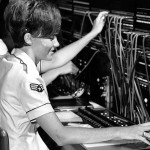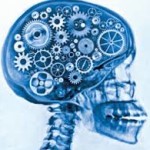Bias dynamics in A.I.
The more algos we live by, the more “Computer Scientists Find Bias in Algorithms” as the story by Lauren J. Young tells us.
We may, of course, think that bias is unavoidable, so the best we can do is be aware and go on. How much aware may find some psychological or commercial barriers, as in Jerry Kaplan’s “Would You Buy a Car That’s Programmed to Kill You? You Just Might.”
Maybe we can only hope that something good may come from algos interacting and trying to learn what are their new preferred actions (from their adjusted biases) as Daniel Hennes and Michael Kaisers paper on “Evolutionary Dynamics of Multi-Agent Learning” indicates its possible.
‘Stop the whining!’ – said the robot
One doesn’t have to wait long until a new story comes up showing how humans are already obsolete. Robots are taking our jobs and there’s no scape from it.
Recent examples can be found in Will Knight’s two recent articles at MIT Tech review “New Boss on Construction Sites Is a Drone” and “Robots Learn to Make Pancakes from WikiHow Articles“.
Less often we find stories such as “Technology has created more jobs than it has destroyed, says 140 years of data” and suddenly we feel lighter. Technology will provide us new jobs. Of course this is not played well for typists, lamplighter, ice cutters, etc, but at least there’s hope.
Richard Newton’s “Visions of a future beyond abundance and lolling” tries a calmer, optimistic if not skeptical approach.Continue reading→
Ashley Madison hack, marriage and technology
Links via Azeem Azhar’s great Exponential View:
As people discuss Ashley Madison’s hack repercussions, this interview with the hackers is informative.
Moving to how people see traditional marriage going forward survey of futurists overwhelmingly supported plural marriages.
And then we are back to old theme of repressing women and their insolent attempt to do what they think they want as the last two hundred years have been filled with moral panics about women using technologies for libertine ends.
Javascript, pop-ups and ad-blocking
“The ethics of modern web ad-blocking” – by Marco Arment
“The ethics of modern web ad-blocking
(…) Pop-up-blocking software boomed, and within a few years, every modern web browser blocked almost all pop-ups by default.
(…) People often argue that running ad-blocking software is violating an implied contract between the reader and the publisher: the publisher offers the page content to the reader for free, in exchange for the reader seeing the publisher’s ads. And that’s a nice, simple theory, but it’s a blurry line in reality.Continue reading→
Learning about our minds while teaching machines how to learn
Writing an algorithm requires a reflection of what steps, and their internal relations, are necessary to determine a desired output correctly. Such reflection exercise involving logical and abstraction considerations not only about the operations to be performed but also, in depth, studying how our mind process that same operations. A couple of recent articles explore that cyclical effort.
“Algorithms of the Mind – What Machine Learning Teaches Us About Ourselves” by Christopher Nguyen and “Are You a Thinking Thing? Why Debating Machine Consciousness Matters” by Alison E. Berman aproach interesting points of this case.Continue reading→
“Why Email Is Broken—and What Will Replace It” by PETER DIAMANDIS
“If you need to communicate something important to a friend, do you call? Visit? Email? Text? Skype? WhatsApp? Snap? Tweet? Message on Facebook or LinkedIn? (…)
As more and more tools become available, we seem to have accepted the notion that communication is “contextual”: LinkedIn is for work. Facebook is for friends. Snapchat is for close friends. Texting is for something immediate, if not urgent. Slack is for your team.Twitter is for public broadcast. Skype is for long distance. Phone calls are for intimacy or something really important.
And a lot of people make the mistake of thinking that email is, well, good enough.(…)
If the email is more than a few lines long, I don’t read it.
If I don’t get the point in the first couple of lines, I stop reading.Continue reading→
“Artificial Intelligence Is Already Weirdly Inhuman” by DAVID BERREBY
From Nautilus, Dark Matter issue via Azeem Azhar:
“…Artificial intelligence has been conquering hard problems at a relentless pace lately (…) neural network has equaled or even surpassed human beings at tasks like discovering new drugs, finding the best candidates for a job, and even driving a car.
(…) some hard problems make neural nets respond in ways that aren’t understandable.
(…) Not knowing how or why a machine did something strange leaves us unable to make sure it doesn’t happen again.
But the occasional unexpected weirdness of machine “thought” might also be a teaching moment for humanity. (…) they might show us how intelligence works outside the constraints of our species’ limitations. (…)” read full article
“The Neuron’s Secret Partner: Glial cells…” by FERRIS JABR
Article by Ferris Jabr, illustrated by Jackie Ferrentino, featured in Nautilus
“When we speak of brain cells we usually mean neurons: (…) The rest, known as neuroglia or simply glia, have long lived in the neuron’s shadow.
(…) By the early 1900s, that notion had begun to erode. (…) From the 1960s onward (…) neuroscientists confirmed that glia are the brain’s architects, doctors, police, janitors, and gardeners. In the last five years, researchers have finally brought glia into the limelight as the highly dynamic, incomparably versatile, and indispensable partners of the neuron. Here are five recently discovered roles glia play in the brain:
Wiring – (…) radial glial cells form a widespread lattice of cables along which neurons crawl like inchworms (…) A series of studies in the last three years have also confirmed that some glial cells excrete molecules that promote the formation of new connections between neurons, while others engulf and digest weak and underused synapses, changing the brain’s micro-circuitry throughout life.
Clearing Clutter – (…) Microglia roam about scavenging harmful tangles of proteins, the remains of dead cells, and bits of unneeded DNA. But a study published just last year indicated that microglia are essential for eliminating clumps of amyloid beta and other protein clusters associated with Alzheimer’s and related neurodegenerative disorders. (…)
Helping Neurons Talk – (…) oligodendrocyte precursor cell (OPC) is one of the most unique and active types of glia. (…) OPCs form synapses with neurons and change their own behavior (…)
Helping You Breathe – (…) When glia known as astrocytes detected a drop in blood pH, which would correspond to elevated levels of carbon dioxide, they increased (…) the breathing rate in live rats, eventually bringing more oxygen to the brain. Raising the pH, which would correlate with oxygenated blood, had the opposite effect. (…)
Making You Smart – By absorbing and releasing neurotransmitters, and thereby modifying the availability of these molecules, astrocytes change how frequently and forcefully neurons fire” read full story
New economy – old problems
NY Times article By Jodi Kantor and David Streitfeld exposed workplace issues Inside Amazon, and many great pieces written on the aftermath – among them one particularly good was by John Cassidy at The New Yorker.
Published right before NY Times’, one can only wonder what a great input would have been if Inside Amazon debate was to be taken into directly into consideration at “Networks and the Nature of the Firm” by Tim O’Reilly. This takes on a broader view on the new economy.
From Tim O’Reilly’s bigger picture to a inside dive into amazon jungle these articles compose an interesting triptych.
Empathy, Authority, and Virtual Reality
Suggestion has been used for a long time by pseudo-psychics, hypnotism, and other form of magicians. Regardless of some straight-out frauds, this is telling of the way our mind interprets perceptions does not conform to a deterministic way people sometimes try to see their ‘reasoning’.
An important factor on most of the explored means of tapping into suggestion was interaction with other person (the hypnotist). Authority plays a major role in this. As human communication is more and more mediated by technology, would our perception of authority be migrating as well? One may see a big data miracle if amazon guess someone is pregnant by her shopping history, but take for granted if a local pharmacist do so?
Would empathy, hand-in-hand with suggestion and authority, be migrating to be mediated by virtual reality?
Not surprisingly, as businesses get the taste of the market potential of this shift, here is a new batch of articles on the matter. Too many in this trendy topic to pick one, sorry.
“Inside the Empathy Machine: VR, Neuroscience, Race and Journalism” by Joel Beeson at Media Shift.
“NFL Commissioner Roger Goodell steps into virtual reality at Stanford lab” by Bjorn Carey
“The Limits of Virtual Reality: Debugging the Empathy Machine” by Ainsley Sutherland from MIT
“The Future of Empathy-Generating Virtual Reality Is Here” by Bill Desowitz
“How virtual reality can create the ultimate empathy machine” – TED Talk with Chris Milk
“CAN VIRTUAL REALITY MAKE YOU A BETTER PERSON?” by Stern Strategy Group
“Is It Really So Bad If We Prefer Virtual Reality to Reality?” by Sveta McShane









